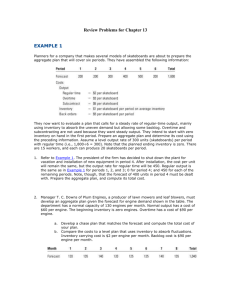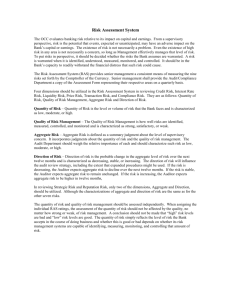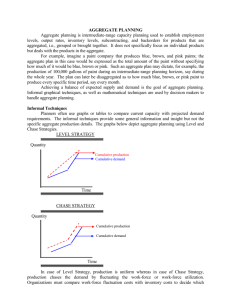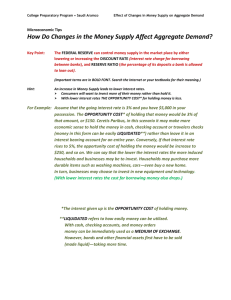Aggregate Planning
advertisement
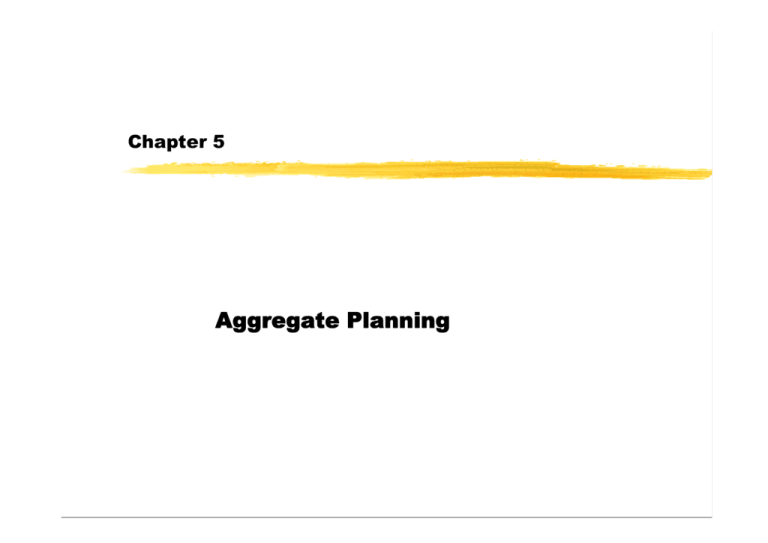
Chapter 5
Aggregate Planning
Supply Chain Planning Matrix
longterm
procurement
distribution
sales
Strategic Network Planning
midterm
shortterm
production
Master Planning
Material
Requirements
Planning
Production
Planning
Distribution
Planning
Scheduling
Transport
Planning
Production Management
Demand
Planning
Demand
Fulfilment &
ATP
44
Supply Chain Planning Matrix
× physical distribution
structure
sales
× materials program
× supplier selection
× cooperations
× personnel planning
× material requ.
planning
× contracts
× master production
scheduling
× capacity planning
× distribution
planning
× mid-term sales
planning
× personnel planning
× ordering materials
× lot-sizing
× machine scheduling
× shop floor control
× warehouse
replenishement
× transport planning
× short-term sales
planning
shortterm
× plant location
× production system
distribution
longterm
production
midterm
procurement
× product program
× strategic sales
planning
information flows
flow of goods
Production Management
45
Aggregate Planning
Example:
one product (plastic case)
two injection molding machines, 550 parts/hour
one worker, 55 parts/hour
steady sales 80.000 cases/month
4 weeks/month, 5 days/week, 8h/day
how many workers?
in real life constant demand is rare
change demand
produce a constant rate anyway
vary production
Production Management
46
Aggregate Planning
Influencing demand
do not satisfy demand
shift demand from peak periods to nonpeak periods
produce several products with peak demand in different period
Planning Production
Production plan: how much and when to make each product
rolling planning horizon
long range plan
intermediate-range plan
⌧units of measurements are aggregates
⌧product family
⌧plant department
⌧changes in workforce, additional machines, subcontracting, overtime,...
Short-term plan
Production Management
47
Aggregate Planning
Aspects of Aggregate Planning
Capacity: how much a production system can make
Aggregate Units: products, workers,...
Costs
⌧production costs (economic costs!)
⌧inventory costs(holding and shortage)
⌧capacity change costs
Production Management
48
Aggregate Planning
Spreadsheet Methods
Zero Inventory Plan
Precision Transfer, Inc. Produces more than 300 different precision
gears ( the aggregation unit is a gear!).
Last year (=260 working days) Precision made 41.383 gears of various
kinds with an average of 40 workers.
41.383 gears per year
40 x 260 worker-days/year = 3,98 -> 4 gears/ worker-day
Aggregate demand forecast for precision gear:
Month
Demand
January
2760
February
March
3320
3970
April
3540
Production Management
May
3180
June
2900
Total
19.670
49
Aggregate Planning
holding costs: $5 per gear per month
backlog costs: $15 per gear per month
hiring costs: $450 per worker
lay-off costs: $600 per worker
wages: $15 per hour ( all workers are paid for 8 hours per day)
there are currently 35 workers at Precision
currently no inventory
Production plan?
Production Management
50
Aggregate Planning
Zero Inventory Plan
produce exactly amount needed per period
adapt workforce
Production Management
51
Aggregate Planning
10
9
Number of Workers (hired / laid off)
8
6
4
2
2
Change in Workforce
0
-1
-2
-2
-4
-4
-6
-6
-8
January February
March
April
May
June
Month
Production Management
52
Aggregate Planning
Level Work Force Plan
backorders allowed
constant numbers of workers
demand over the planning horizon
gears a worker can produce over the horizon
19670/(4x129)=38,12 -> 39 workers are always needed
Production Management
53
Aggregate Planning
Inventory: January: 3276 - 2760 = 516
February: 516 + 3120 – 3320
March: 316 + 3588 – 3670 = -66! -Backorders: 66 x $15 = $990
516
500
400
358
316
300
200
net inventory
100
0
0
-66
-100
-78
-200
-300
-330
ne
Ju
M
ay
pr
il
A
M
ar
ch
y
br
ua
r
Fe
nu
ar
y
-400
Ja
number of units (inventory / back-orders)
600
Month
Production Management
54
Aggregate Planning
no backorders are allowed
workers= cumulative demand/(cumulative days x units/workers/day)
January: 2760/(21 x 4) = 32,86 -> 33 workers
February: (2760+3320)/[(21+20) x 4] = 37,07 -> 38 workers.
March: 10.050/(64 x 4) =>40 workers
April: 13.590/(85 x 4) => 40 workers
May: 16.770/(107 x 4) => 40 workers
June: 19670/(129 x 4) => 39 workers
Production Management
55
Aggregate Planning
Example Mixed Plan
The number of workers used is an educated guess based on the zero
inventory and level work force plans!
Production Management
56
Spreadsheet Methods Summary
Zero-Inv.
Level/BO Level/No BO
Mixed
Hiring cost
4950
1800
2250
3150
Lay-off cost
7800
0
0
4200
59856
603720
619200
593520
Holding cost
0
4160
6350
3890
BO cost
0
7110
0
990
611310
616790
627800
605180
33
39
40
35
Labor cost
Total cost
Workers
Production Management
57
Aggregate Planning
Linear Programming Approaches to Aggregate Planning
Production Management
58
Aggregate Planning
Production Management
59
Aggregate Planning
Decision Variables:
Pt K number of units produced in period t
Wt K number of workers available in period t
H t K number of workers hired in period t
Lt K number of workers laid off in period t
I t K number of units held in inventory in period t
Bt K number of units backordered in period t
Production Management
60
Aggregate Planning
Production Management
61
Aggregate Planning
Example: Precision Transfer
Planning horizon: 6 months T= 6
Costs do not vary over time CtP = 0
dt : days in month t
CtW = $120dt
CtH = $450
CtL = $600
CtI = $5
We assume that no backorders are allowed!
no production costs and no backorder costs are included!
Demand
⌧January
2760
February March
3320
3970
April
3540
Production Management
May
3180
June
2900
Total
19.670
62
Linear Program Model for Precision
Transfer
Production Management
63
Aggregate Planning
LP solution (total cost = $600 191,60)
January
February
March
April
May
June
Production Inventory Hired
Laid off Workers
2940,00
180,00
0,00
0,00
35,00
3232,86
92,86
5,41
0,00
40,41
3877,14
0,00
1,73
0,00
42,14
3540,00
0,00
0,00
0,00
42,14
3180,00
0,00
0,00
6,01
36,14
2900,00
0,00
0,00
3,18
32,95
Production Management
64
Aggregate Planning
Rounding LP solution
January
Days
Units/Worker
Demand
Workers
Capacity
Capacity - Demand
Cumulative Difference
Produced
Net inventory
Hired
Laid Off
Costs
21
84
2760
35
2940
180
180
2930
170
0
0
89050
February March
April
May
June
Total
20
23
21
22
22
129
80
92
84
88
88
516
3320
3970
3540
3180
2900
19670
229
41
42
42
36
33
3280
3864
3528
3168
2904
19684
-40
-106
-12
-12
4
14
140
34
22
10
14
400
3280
3864
3528
3168
2900
19670
130
24
12
0
0
336
6
1
0
0
0
7
0
0
0
6
3
9
101750 116490
105900
98640
88920
600750
Production Management
65
Aggregate Planning
Practical Issues
100.000 variables and 40.000 constraints
LP/MIP Solvers: CPLEX, XPRESS-MP, ...
Extensions
Bounds
I t ≤ I tU
I Lt ≤ I t ≤ I tU
L t ≤ 0.05Wt
Training
Wt = Wt −1 + H t −1 − Lt
Production Management
66
Aggregate Planning
Transportation Models
supply points: periods, initial inventory
demand points: periods, excess demand, final inventory
ntWt = capacity during period t
Dt = forecasted number of units demanded in period t
CPt = the cost to produce one unit in period t
CIt = the cost to hold one unit in inventory in period t
Production Management
67
Aggregate Planning
initial inventory: 50
final inventory: 75
Production Management
68
Aggregate Planning
Beginning
inventory
Period 1
Excess
capacity
0
2
4
6
0
10
12
14
16
0
350
2
3
50
150
50
-
Period 2
11
75
75
13
15
0
300
12
14
0
350
300
-
Period 3
Demand
Ending
inventory
Available
capacity
50
1
200
300
350
400
Production Management
75
75
1050
69
Aggregate Planning
Extension:
t
capacity n tW t
demand
production costs
holding costs
1
2
3
350 350 300
400 300 400
10 11 12
2
2
2
⌧overtime: overtime capacity is 90, 90 and 75 in period 1, 2 and 3;
⌧overtime costs are $16, $18 and $ 20 for the three periods respectively;
⌧backorders:units can be backordered at a cost of $5 per unit-month;
production in period 2 can be used to satisfy demand in period 1
Production Management
70
Aggregate Planning
1
0
Beginning inventory
Period 1
Regular
time
Overtime
Period 2
2
Excess
capacity
Available
capacity
4
6
0
25
10
12
14
16
0
16
18
20
22
0
350
50
40
16
Regular
time
11
13
275
23
15
0
22
0
75
18
20
90
22
Regular
time
17
12
14
0
20
22
0
300
30
Overtime
Demand
Ending
inventory
3
25
Overtime
Period 3
2
400
25
300
75
400
Production Management
75
130
50
350
90
350
90
300
75
1305
71
Aggregate Planning
Disaggregating Plans
aggregate units are not actually produced, so the plan should consider
individual products
disaggregation
master production schedule
Questions:
In which order should individual products be produced?
⌧e.g.: shortest run-out time Ri = I i / Di
How much of each product should be produced?
⌧e.g.: balance run-out time
Production Management
72
Aggregate Planning
Advanced Production Planning Models
Multiple Products
same notation as before
add subscript i for product i
Objective function
N
⎛ W
⎞
H
L
P
I
min ∑ ⎜ Ct Wt + Ct H t + Ct Lt + ∑ Cit Pit + Cit I it ⎟
t =1 ⎝
i =1
⎠
T
Production Management
73
Aggregate Planning
subject to
⎛ 1
⎜
∑
i=1 ⎝ nit
N
⎞
⎟ Pit ≤ Wt
⎠
t = 1, 2,..., T
Wt = Wt −1 + H t − Lt
t=1,2,...,T
Iit = I it −1 + Pit − Dit
t=1,2,...,T; i=1,2,...,N
Pit,Wt , H t , Lt , I it ≥ 0
t=1,2,...,T; i=1,2,...,N
Production Management
74
Aggregate Planning
Computational Effort:
10 products, 12 periods: 276 variables, 144 constraints
100 products, 12 periods: 2436 variables, 1224 constaints
Production Management
75
Aggregate Planning
Example: Carolina Hardwood Product Mix
⌧Carolina Hardwood produces 3 types of dining tables;
⌧There are currently 50 workers employed who can be hired and laid off at
any time;
⌧Initial inventory is 100 units for table1, 120 units for table 2 and 80 units for
table 3;
Production Management
76
Aggregate Planning
⌧The number of units that can be made by one worker per period:
⌧Forecasted demand, unit cost and holding cost per unit are:
Production Management
77
Aggregate Planning
Production Management
78
Aggregate Planning
Multiple Products and Processes
Production Management
79
Aggregate Planning
Production Management
80
Aggregate Planning
Example: Cactus Cycles process plan
CC produces 2 types of bicycles, street and road;
Estimated demand and current inventory:
available capacity(hours) and holding costs per bike:
t
1
2
3
Capacity(hours)
Holding
Machine Worker Street Road
8600 17000
5
6
8500 16600
6
7
8800 17200
5
7
Production Management
81
Aggregate Planning
process costs ( process1, process2) and resource requirement per unit:
Production Management
82
Aggregate Planning
Production Management
83
Aggregate Planning
solution: Objective Function value = $368,756.25
Production Management
84
Aggregate Planning - Extensions
Hopp/Spearman, S. 522-540
Notation:
X it ... amount of product i produced in period t
ri K net profit from one unit of product i
Sit K amount of product i sold in period t
a ij K time required on workstation j to produce one unit of product i
c jt K capacity of workstation j in period t in units (consistent with a ij )
Production Management
85
Aggregate Planning - Extensions
Backorders
t
m
max ∑∑ ri Sit − hi I it+ − π i I t−
t =1 i =1
subject to
d it ≤ Sit ≤ d it
m
∑a
for all i,t
X it ≤ c jt
for all j,t
I it = I it −1 + X it − Sit
for all i,t
I it = I it+ − I it−
for all i,t
X it , Sit , I it+ , I it− ≥ 0
for all i,t
i =1
ij
Production Management
86
Aggregate Planning - Extensions
Overtime
l ′j = cost of one hour of overtime at workstation j
O jt = overtime at workstation j in period t in hours
n
⎧m
⎫
+
−
max ∑ ⎨∑ (ri Sit − hi I it − π i I it ) − ∑ l ′O jt ⎬
t =1 ⎩ i =1
j =1
⎭
subject to
t
m
∑a
i =1
ij
X it ≤ c jt + O jt
for all i,t
X it , Sit , I it+ , I it− , O jt ≥ 0
for all i,t
Production Management
87
Aggregate Planning - Extensions
Yield loss
1−α
α
1− β
1− γ
β
γ
α , β , γ K fraction of output that is lost
yij K cumulative yield from station j onward
(including station j) for product i
we must release
d
units of i into station j
y ij
Production Management
88
Aggregate Planning - Extensions
Basic model + Yield loss extension (no backorders)
t
m
max ∑∑ (ri S it − hi I it )
t =1 i =1
subject to
d it ≤ Sit ≤ d it
m
∑
a ij X it
yij
for all i,t
≤ c jt
for all j,t
I it = I it −1 + X it − Sit
for all i,t
X it , Sit , I it ≥ 0
for all i,t
i =1
Production Management
89
Aggregate Planning - WorkforcePlanning
Single product, workforce resizing, overtime allocation
Notation
b = number of man - hours required to produce one unit of product
l = cost of regular time in dollars/man - hour
l ′ = cost of overtime in dollars/man - hour
e = cost to increase workforce by one man - hour per period
e′ = cost to decrease workforce by one man - hour per period
Wt = workforce in period t in man - hours of regular time
H t = increase in workforce from period t - 1 to t in man - hours
Ft = decrease in workforce from period t - 1 to t in man - hours
O t = overtime in period t in hours
Production Management
90
Aggregate Planning - WorkforcePlanning
LP formulation:
maximize net profit,
including labor,
overtime, holding, and
hiring/firing costs
subject to constraints
on sales, capacity,...
t
{
max ∑ rS t − h I t − lWt − l ′Ot − eH t − e′Ft
}
t =1
subject to
d t ≤ St ≤ d t
for all t
a j X t ≤ c jt
for all j, t
I t = I t −1 + X t − S t
for all t
Wt = Wt −1 + H t − Ft
for all t
bX t ≤ Wt + Ot
for all t
X t , St , I t , Ot ,Wt , Ft , H t , ≥ 0 for all t
Production Management
91
AP-WP Example
Revenue: 1000$
worker capacity: 168h/month
initially 15 workers
no initial inventory
holding costs: 10$/unit/month
regular labor costs: 35$/hour
overtime: 150% of regular
hiring costs: 2500$ (2500/168 ~ 15$ per man-hour)
lay-off costs: 1500$ (1500/168 ~ 9$ per man-hour)
no backordering
demands over 12 months:
200, 220, 230, 300, 400, 450, 320, 180, 170,170, 160, 180
demands must be met! (S=D)
Production Management
92
AP-WP Example(cont.)
Determine over a 12 month horizon:
Number of workers: W
Output: X
Overtime use: O
Inventory: I
(H, F are additional choice variables in the model)
Production Management
93
Aggregate Planning - WorkforcePlanning
Production Management
94
Aggregate Planning - WorkforcePlanning
Production Management
95
Aggregate Planning - WorkforcePlanning
Production Management
96
Aggregate Planning-Summary
The following scenarios have been discussed:
single product, single resource, single process
find: workforce, output, inventory (w. or w/o backorders)
multiple products, single resource, single process
find: workforce, all outputs, all inventories (w. or w/o backorders)
multiple products, multiple resources, multiple processes
(workforce given)
find: all outputs, all inventories, use of processes
Production Management
97
Aggregate Planning-Summary
The following scenarios have been discussed:
multiple products, multiple workstations
(workstation capcities given)
find: all sales, all outputs, all inventories (w. or w/o backorders)
multiple products, multiple workstations
find: all sales, all outputs, all inventories (w. or w/o backorders), OT
single product, multiple workstations, one resource
find: workforce, all sales, all outputs, all inventories (w. or w/o backorders),
OT
Production Management
98
Aggregate Planning
Work to do:
Examples: 5.7, 5.8abcdef, 5.9abcd, 5.10abcd, 5.16abcd, 5.21,
5.22, 5.29, 5.30
Replace capacity columns of table in problem 5.29 with
Month Machine Worker
1
1350
19000
2
1270
19000
3
1350
19500
Minicase BF SWING II
Production Management
99


